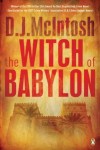The Witch of Babylon by D.J. McIntosh
 Are you in the mood for a puzzle? Do you enjoy ancient mysticism married to contemporary thrills? Mysterious. Exotic. And even contentious. Meet The Witch of Babylon’s author D.J. McIntosh.
Are you in the mood for a puzzle? Do you enjoy ancient mysticism married to contemporary thrills? Mysterious. Exotic. And even contentious. Meet The Witch of Babylon’s author D.J. McIntosh.
Here’s the cover copy for her forthcoming June release:
Out of the searing heat and sandstorms of Baghdad’s infamous summer of 2003 comes The Witch of Babylon, a gripping tale rooted in ancient Assyrian lore and its little known but profound significance for the world. John Madison, a Turkish-American art dealer, caught between his brother’s obsession to save a priceless relic and a deadly game of revenge staged by his childhood friend, must find the link between a modern day witch and an ancient one.
Already sold in over twenty countries The Witch of Babylon has the makings of a blockbuster debut.
“Soaked in the blood of centuries, yet fresh as tomorrow’s headlines, D.J. McIntosh is articulate, literate and scary.” Alan Bradley, award winning author of The Sweetness at the Bottom of the Pie.
“From Iraq, ancient history and alchemy combine to terrorize us in this stunning historical thriller.” Louise Penny, New York Times bestselling author of the Chief Inspector Gamache series.
Congratulations, DJ and welcome. I feel very prepared for this interview as I solved the mystery game on your website and uncovered the Babylonian tablet! To tell you a secret I actually played the game three times when I should have been writing.
Thank for taking the time to tell us about your debut novel The Witch of Babylon.
Part of your novel’s allure for me lies in the ‘where’ and the ‘when’; could you set up the story for us? As the book opens, what’s happening at this critical juncture in the history of Iraq?
Having routed Iraq’s military, U.S. and British soldiers are consolidating their hold on the country. Guerilla fighters are marshalling their forces. Kidnappings, IAD and mortar strikes, assassinations, are mounting although significant sectarian violence has not yet emerged. Especially for cities in central and south Iraq, the infrastructure – hydro, water supply, medical assistance, are in a total shambles. In the high heat of summer civilian suffering is very great. On August 19th 2003 a turning point came with the devastating bombing attack on the Canal Hotel, headquarters for the UN mission in Iraq. 22 people died in the blast including the head of mission and 100 were wounded.
And within this crucible of events enters John Madison, a New York art dealer caught up in the aftermath of the looting of the Baghdad Museum. Can you tell me more about his history and what motivates him?
Born in Turkey, at the age of three Madison loses his parents in a mining disaster. He’s taken into the care of his much older brother, Samuel, in New York. Growing up under the shadow of his brother, a celebrated archaeologist, Madison always felt second best. As a teenager he acted out but in his mid-twenties settled into his profession as an art and antiquities dealer. While he doesn’t hesitate to “cross the line” if a lucrative opportunity opens up, he’s clever enough not to take unwise risks. He wants to make a name for himself but finds that he’s suddenly caught up in a deadly game of revenge staged by an old childhood friend.
What of the antagonist? Do we know who he/she is from the start of the novel or is that part of the 3,000 year old conspiracy we get to watch John unravel?
I have to give you both a yes and no here. That is, two of the antagonists are known early on although the reader does not have the full picture on exactly why they are hunting John Madison. They are part of a group of five antagonists who keep their identities secret, their images pictured only on their website through Venetian porcelain masks. Motivations and names of all the antagonists are not revealed until the end.
Mythology plays an important role in the story. Can you tell me what we know of the various Mesopotamian mythologies and the myth that The Witch of Babylon is centered upon?
 Well, although I am not a scholar, I could go on for pages about the Mesopotamians but one notable area that intrigues me is how Mesopotamian mythology influenced the Old Testament. The Flood Story is perhaps the most famous example. The tale originated as a Sumerian myth, was subsequently repeated and expanded upon by the Assyrians and then re-shaped in its present Old Testament form. That process, to me, is fascinating. I’m afraid I can’t tell you which myth The Witch of Babylon is centered on because it would give away the book’s secret.
Well, although I am not a scholar, I could go on for pages about the Mesopotamians but one notable area that intrigues me is how Mesopotamian mythology influenced the Old Testament. The Flood Story is perhaps the most famous example. The tale originated as a Sumerian myth, was subsequently repeated and expanded upon by the Assyrians and then re-shaped in its present Old Testament form. That process, to me, is fascinating. I’m afraid I can’t tell you which myth The Witch of Babylon is centered on because it would give away the book’s secret.
On your website you mention that in the Bible, the Assyrians and Babylonians of Mesopotamia were painted with a very dark brush. And you ask the question: Was this portrait deserved? Is this a fundamental question of the book? What are you hoping that the reader takeaway besides entertainment?
No, it’s not a fundamental question but I would say it is a significant one. Despite the intensive media coverage of Iraq over the last eight years, little has been said about the country’s remarkable history and cultural legacy. Mesopotamians easily matched the Egyptians in cultural and scientific achievements. They gave us the written word. So I hope “The Witch” will give readers a taste of this and a desire to learn more.
Also on your site you quote a Sumerian legend written about Sargon,
“I did not know any father… My mother conceived me and bore me in secret. She put me in a little box made of reeds, sealing its lid with pitch. She put me in the river… The river carried me away and brought me… (to a) drawer of water… (who) adopted me and brought me up as his son.” As you say, it sounds like the story of Moses, but it’s not. How controversial is your novel from a mainstream religion standpoint?
Pretty much although it stays within the confines of the Old Testament and does not touch on the life of Christ. For example, a new way of looking at the Cain and Abel tale is to see that it was written from the standpoint of Judaic nomadic communities whose enemies were the city builders (Caananites and Assyrians) Thus you have Cain, the father of cities cast as villain and Abel, the shepherd as innocent victim. My source for this came from a marvellous book: The Bible Unearthed by Israel Finkelstein and Neil Asher Silberman.
Your interests don’t stop at mythology and history but you are also active in the organizations Reporters Sans Frontieres and the Committee to protect Journalists. On your website you post information regarding several atrocities including the Amiriyah Shelter Bombing and the experience of Mazen Dana. Why? And how do these tie into your novel?
Both are iconic moments that put the two major recent conflicts in Iraq into perspective. The fate of journalists in Iraq is a key theme in the novel.
This is a trilogy, how does the rest play out? Do we follow John and his love interest? What separates each novel?
I see the three novels not as a traditional series but more like a tri-partite whole as if they were three volumes of one work. John Madison is the leading man in each of them. All three novels take place at a specific month of year on the Assyro-Babylonian calendar and have the characteristics of that month, foretelling the tone of the novel. For example, The Witch focuses on the Assyrian empire, in the month of Nissan ruled by the god Shamash and “heat” is a constant presence throughout the novel. In Book Two, folk tales rather than Biblical myths are explored and the Babylonian empire featured. Book Three, turns to the Sumerians and the true origin of angels. This last subject has become somewhat overexposed in current antiquity thrillers so I hasten to add, it has nothing to do with the Nephilim.
It’s been a pleasure speaking with you DJ, thank you for your time and good luck with the launch of your series. You may have figured out how to turn paper in gold!
Thank you for such great questions!
D.J. McIntosh is a member of the Canadian Society for Mesopotamian Studies and a former co-editor of Crime Writers of Canada’s newsletter “Fingerprints.” She is a strong supporter of Reporters Sans Frontieres and the Committee to protect Journalists.
She divides her time between her cottage on the shores of Lake Huron and Toronto where she is able to indulge her love of live music and museums.
For more information, please visit her website.
- The Bourne Retribution by Eric Van Lustbader - November 30, 2013
- Nightlife by Matthew Quinn Martin - October 31, 2013
- Bones of the Lost by Kathy Reichs - August 31, 2013

